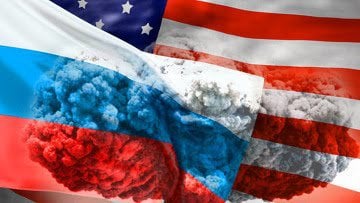Countering The Islamic State (ISIS)? The Russia-US Standoff in Central Asia
Foreign Policy Diary

On Monday U.S. Secretary of State John Kerry visited Kazakhstan. It was the day after his meeting with the foreign ministers of five Central Asian countries in Samarkand, Uzbekistan. His visit to Kazakhstan kicked off a tour of each of the Central Asian countries — the first such tour conducted by a U.S. secretary of state. It marks the importance of Central Asia for the US synchronized with the negative tendencies for the US foreign policy in Afghanistan where the government set by the United States is losing a civil war to the Taliban movement and its allied militant groups.
At the Samarkand meeting, Kerry and the foreign ministers from Kazakhstan, Kyrgyzstan, Turkmenistan, Tajikistan and Uzbekistan publicly discussed areas of cooperation as diverse as economics, water security and education. However, it was only the gambit for discussing additional issues during Kerry’s visits to individual countries. The easily forecasted goal will be to consider the topics related to Afghanistan and Russia.
Transcript
The borders between the Central Asian states and Afghanistan have become increasingly active in terms of militant, diplomatic and security activity. Militant activity has increased in northern Afghanistan in recent months, punctuated by Taliban forces’ capture of the town of Kunduz in late September and ISIS militants have been gathering momentum and concentrating there. ISIS militants see this region as a foothold for further expansion into Central Asia. The important fact is they don’t fight foreign or Afghan government troops. They conserve and gather strength. The threat is also growing in the South. Three months ago, we’ve already pointed out that the number of ISIS militants has been growing at the borders of Tajikistan and Turkmenistan. We also noted serious domestic problems of the Central Asian states.
This situation conducts concerns not only for the Central Asian states but also for countries that are influential in security matters in the region — chiefly Russia, the United States and China interested in the region’s economics. At a recent Collective Security Treaty Organization summit, Russia announced plans to establish a joint border security initiative that reportedly would involve several Central Asian states.
According to our information, additional Russian and Kazakh armed forces have been deployed in the region under the Collective Security Treaty Organization (CSTO) since June, 2015. The Chinese intelligence specialists have joined the Russian and Kazakh servicemen.
The current general structure of the deployed allied armed forces in Tajikistan includes:
• The border guards’ first line: Tajik border outposts, joint frontier posts and border control composed of troops from Russia, Kazakhstan and Tajikistan; Russian and Kazakh military advisers present at the Tajikistan border outposts.
• Units of Tajik army have been bolstered by Russian and Kazakh military advisers, down to squad level in some rapid reaction and special units.
• There are Russian, Kazakh and Belarusian military formations (though Belarus’ contribution is a small) being based at the 201st Russian Military Base around Dushanbe, Kulyab and Kurgan-Tyube
• Other units and infrastructure of CSTO and the Regional Counter-Terrorist Structure of Shanghai Cooperation Organisation (RCTS) include Russian, Kazakh and Chinese intelligence assets.
Not all countries are supporting the CSTO’s efforts. Turkmenistan and Uzbekistan are discussing their own border security operations outside of the Russian initiative. Indeed, these countries always preferred to avoid a close cooperation through CSTO. Experts point out that the ambitions of the countries’ leaders are a reason of such attitude. At the moment, Ashgabat and Tashkent are trying to set a bilateral partnership in the security sphere. SouthFront: Analysis & Intelligence has information that Turkmenistan has pulled almost 70% of its military to the Afghani border and tries to block it what was hardly possible even in the times of the USSR.
This has drawn the United States’ attention. Washington, like Moscow, is concerned about the rise of militancy in Afghanistan. But Washington is interested in strengthening security cooperation with Central Asian states not only to prevent a spillover of militancy there, but also to challenge Moscow as a dominant military and security power in the region. Washington’s motives for cooperation in Central Asia are clear, but the details of how the United States intends to enhance security cooperation in the region are hazy. Nonetheless, there are several possible topics for the Kerry’s voyage in Central Asia.
Turkmenistan could grant the United States use of the Mary-2 air base located near the Turkmen border with Afghanistan, though Ashgabat has officially denied that the offer is on the table. Another possible plan is the potential U.S. support of a joint Uzbek-Turkmen border security initiative. Another topic is the rise of the US presence in Tajikistan. Tajikistan is considered one of Russia’s closest allies in Central Asia, but Washington would like to expand in the country.
None of these forms of cooperation are confirmed, and none of them are inevitable, but these attempts would certainly draw Russia’s attention. Separation of the efforts will establish breaches in the regional security system setting by Russia. The Afghani case has clearly shown that the US military force is hardly able to impact the regional security positively. At least, a division of the US Armed Force based there isn’t enough.
Experts believe that only the joined forces of Russia and Kazakhstan are able to counter the ISIS threat quickly and efficiently. Tajikistan and Kyrgyzstan military have lack equipment and suffer from low military effectiveness. Uzbekistan and Turkmenistan are trying to avoid joint CSTO efforts. In general, we could argue that Russia, China, Kazakhstan and other Central Asian states estimate the threat properly and are making intense preparations to meet it.
In turn, the volatile border region between Central Asia and Afghanistan becomes a stake in the evolution of the standoff between the United States and Russia over the entire former Soviet periphery.

